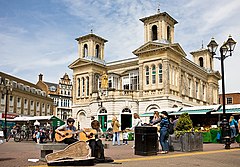Kingston upon Thames
| Kingston upon Thames | |
|---|---|
 Old Town Hall on Market Place |
|
| Kingston upon Thames shown within Greater London | |
| Population | 43,013 |
| OS grid reference | TQ182693 |
| • Charing Cross | 10 mi (16 km) NE |
| London borough | |
| Ceremonial county | Greater London |
| Region | |
| Country | England |
| Sovereign state | United Kingdom |
| Post town | KINGSTON UPON THAMES |
| Postcode district | KT1, KT2 |
| Dialling code | 020 |
| Police | Metropolitan |
| Fire | London |
| Ambulance | London |
| EU Parliament | London |
| UK Parliament | |
| London Assembly | |
Kingston upon Thames, also known as Kingston, is the principal settlement of the Royal Borough of Kingston upon Thames in southwest London. It was the ancient market town where Saxon kings were crowned. Kingston is situated 10 miles (16 kilometres) southwest of Charing Cross and is one of the major metropolitan centres identified in the London Plan. Kingston lies approximately 33 feet (10 metres) above sea level. Kingston was part of a large ancient parish in the county of Surrey and the town was an ancient borough, reformed in 1835. It has been the location of Surrey County Hall from 1893, extraterritorially in terms of local government administration since Kingston became part of Greater London in 1965. Most of the town centre is part of the KT1 postcode area, but some areas north of Kingston railway station have the postcode KT2 instead. The population of the town itself, comprising the four wards of Canbury, Grove, Norbiton and Tudor, was 43,013 in the 2011 census.
Kingston was called Cyninges tun in 838, Chingestune in 1086, Kingeston in 1164, Kyngeston super Tamisiam in 1321 and Kingestowne upon Thames in 1589. The name means 'the king's manor or estate' from the Old English words cyning and tun. It belonged to the king in Saxon times and was the earliest royal borough. It was first mentioned in 838 as the site of a meeting between King Egbert of Wessex and Ceolnoth, Archbishop of Canterbury. Kingston lay on the boundary between the ancient kingdoms of Wessex and Mercia, until in the early tenth century when King Athelstan united both to create the kingdom of England. Probably because of the town's symbolic location, several tenth-century kings were crowned in Kingston, Æthelstan in 925, Eadred in 946 and Æthelred in 978. Other kings who may have been crowned there are Edward the Elder in 902, Edmund in 939, Eadwig in 956, Edgar in about 960 and Edward the Martyr in 975. It was later thought that the coronations took place in the chapel of St Mary, which collapsed in 1730, and a large stone recovered from the ruins has been regarded since the eighteenth century as the Coronation Stone. It was initially used as a mounting block, but in 1850 it was moved to a more dignified place in the market before finally being moved to its current location in the grounds of the guildhall.
...
Wikipedia

